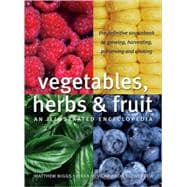
Matthew Biggs lectures at the Royal Horticultural Society. His other books include Matthew Biggs' Complete Book of Vegetables.
Jekka McVicar has won several top awards from the Royal Horticultural Society. Her other books include Jekka 's Culinary Herbs.
Bob Flowerdew is an author and a lecturer for the Royal Horticultural Society.
| Introduction | |
| Vegetables 70+ entries | |
| Herbs 100+ entries | |
| Fruit | |
| Orchard Fruits 15 entries | |
| Soft, Bush, and Cane Fruits 17 entries | |
| Tender Fruits 28 entries | |
| Shrub and Flower Garden Fruits 14 entries | |
| Nuts 12 entries | |
| Practical Gardening 22 entries | |
| The Yearly Calendar | |
| Glossary | |
| Further Reading | |
| Seed Sources | |
| Index | |
| Acknowledgements | |
| Table of Contents provided by Publisher. All Rights Reserved. |
The New copy of this book will include any supplemental materials advertised. Please check the title of the book to determine if it should include any access cards, study guides, lab manuals, CDs, etc.
The Used, Rental and eBook copies of this book are not guaranteed to include any supplemental materials. Typically, only the book itself is included. This is true even if the title states it includes any access cards, study guides, lab manuals, CDs, etc.